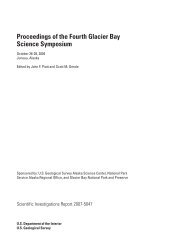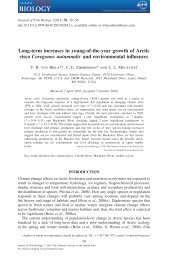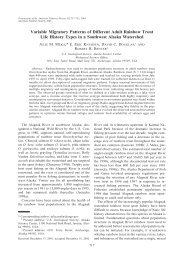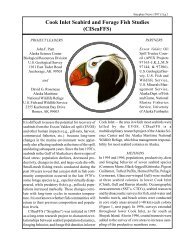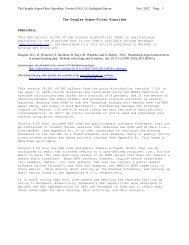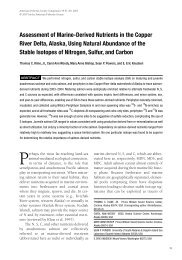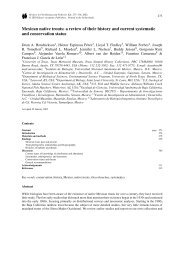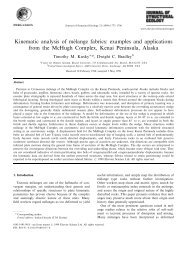Migration of Sakhalin taimen (Parahucho perryi) - Alaska Science ...
Migration of Sakhalin taimen (Parahucho perryi) - Alaska Science ...
Migration of Sakhalin taimen (Parahucho perryi) - Alaska Science ...
Create successful ePaper yourself
Turn your PDF publications into a flip-book with our unique Google optimized e-Paper software.
Environ Biol Fishbroad dietary habits, and threatened status (Holcik etal. 1988; Fukushima et al. 2011). The <strong>Sakhalin</strong> <strong>taimen</strong>was originally in the genus Hucho, but mitochondrialDNA evidence indicates that the species is distinctphylogenetically and should be categorized into aseparate genus (Shed’ko et al. 1996). <strong>Sakhalin</strong> <strong>taimen</strong>,in particular, present unique challenges to conservationdue to their slow growth, delayed age at maturity, andmigratory behavior that potentially increases risk <strong>of</strong>capture in commercial near-shore ocean fisheries. Therange <strong>of</strong> <strong>Sakhalin</strong> <strong>taimen</strong> is restricted to the Russian FarEast mainland along the Sea <strong>of</strong> Japan, and <strong>Sakhalin</strong>,Kuril, and Hokkaido Islands (Zolotukhin et al. 2000).By-catch records <strong>of</strong> the Russian commercial fisherysuggest a greater than 80% decline in abundance <strong>of</strong>P. <strong>perryi</strong>across this region during the past 50 years(Zolotukhin et al. 2002; Rand2006). Populations inJapan are currently found in a few small river basins,and individual river population sizes are estimated tobe typically 8yearsold at time <strong>of</strong> capture. In contrast, Suzuki et al. (2011)found that some fish migrated to sea before age-3. Araiet al. (2004) also examined three juvenile <strong>taimen</strong>(
Environ Biol FishFig. 1 Location <strong>of</strong> Tumnin and Koppi Rivers, Russia and Sarufutsu River, Japan. Darker gray shading indicates the historicdistribution <strong>of</strong> <strong>Sakhalin</strong> <strong>taimen</strong>gorbuscha), white spotted char (Salvelinus leucomaensis),and other migratory and non-migratoryspecies.In 2000 and 2001, sagittal otoliths were collectedfrom nine <strong>taimen</strong> in the Koppi River, three <strong>taimen</strong>captured just outside the mouth <strong>of</strong> the Tumnin River,and two <strong>taimen</strong> captured just outside the mouth <strong>of</strong> theSarufutsu River (Fig. 1). Because <strong>Sakhalin</strong> <strong>taimen</strong> area threatened species and lethal sampling was notprudent, all otoliths were collected from mortalities
Environ Biol Fishthat were incidental to other fisheries or collectedfrom carcasses recovered in freshwater. In addition,sagittal otoliths were collected from a masu salmonand a white spotted char in the Koppi River. The masusalmon and white spotted char were presumed to havemigrated to sea (Arai and Tsukamoto 1998; AraiandMorita 2005) and were included for comparison withputative migratory fish. The otoliths from Koppi andTumnin River fishes were obtained through a jointresearch project involving the Wild Salmon Center andthe Khabarovsk TINRO during 2000–2002. Afterremoval, all otoliths were cleaned and stored in dryvials until analysis.Otolith preparation and analysisThe chemical composition <strong>of</strong> otoliths can be used todescribe migration in anadromous fishes based onexamination <strong>of</strong> the ratio <strong>of</strong> strontium (Sr) and calcium(Ca) (Kalish 1990; Secor 1992; Volk et al. 2000).Strontium, an element with binding characteristicssimilar to Ca, is substituted for Ca in the calciumcarbonate matrix <strong>of</strong> the otolith at levels relative to theconcentration <strong>of</strong> Sr in the environment (Kalish 1990;Zimmerman 2005; Arai 2010). Because Sr/Ca isgenerally greater (3 to 10 x) in seawater comparedto freshwater (Odum 1951) and the concentration <strong>of</strong>Sr is correlated with salinity (Odum 1951; Ingram andSloan 1992; Zimmerman 2005), analysis <strong>of</strong> Sr/Caratios across the otolith <strong>of</strong> a fish can identify growthoccurring in freshwater and saltwater.One sagittal otolith from each fish was embeddedin epoxy (Epo-Thin, Buehler Ltd.) and a transversesection was cut through the core using a diamondwafering saw. Otolith mounting and preparationfollowed the methods <strong>of</strong> Donohoe and Zimmerman(2010). The transverse section was glued to a coverslip attached to a glass slide on one edge and groundwith 2000-grit sandpaper to remove saw marks. Thesection was then polished with a slurry <strong>of</strong> 0.05 μmalumina paste. The cover slip was cut with a scribe sothat several prepared otoliths could be mounted on apetrographic slide for microprobe analysis. Thepetrographic slide containing several otoliths wasrinsed with deionized water, air dried, and carboncoated. Elemental analysis was conducted with aJEOL JXA-8800 L wavelength dispersive microprobe.A 15 kV, 50 nA, 10 μm-diameter beam wasused for all analyses (Zimmerman and Nielsen 2003).Strontiantite (SrCO 3 ) and calcite (CaCO 3 ) were usedas standards for Sr and Ca, respectively. Each elementwas analyzed simultaneously, and a counting time <strong>of</strong>40 s was used to maximize precision (Toole andNielsen 1992). Strontium was measured using theTAP crystal, and Ca was measured using the PETcrystal. A transect <strong>of</strong> points with a spacing <strong>of</strong> 10 to25 μm was measured from the center <strong>of</strong> the core tothe edge <strong>of</strong> the otolith. To quantify the variability <strong>of</strong>otolith Sr/Ca among samples, we calculated thecoefficient <strong>of</strong> variation (CV) as the SD Sr/Ca × meanSr/Ca −1 for each fish. We assumed fish that hadmigrated from freshwater to seawater would havehigher CV than fish that remained in freshwater.After microchemical analysis, the carbon layer wascleaned from the surface <strong>of</strong> otoliths and each otolithwas photographed at a magnification <strong>of</strong> 45x using adigital camera connected to a dissecting microscope.The otolith was placed on a black background andreflected light was used to accentuate the presumedannuli (Fig. 2). The age <strong>of</strong> each fish was determinedby counting alternating translucent and opaqueregions. Under reflected light, annuli correspond tothe translucent zone (Kalish et al. 1995). The distancefrom the center <strong>of</strong> the core to each annulus wasmeasured along a standardized transect. To describethe relation between age and migration, we plottedannuli over transects <strong>of</strong> otolith Sr/Ca.ResultsAges <strong>of</strong> <strong>taimen</strong> examined ranged from 3 to 20, andfork lengths at time <strong>of</strong> capture ranged from 36 to115 cm (Table 1). Otolith Sr/Ca across a transect <strong>of</strong>points beginning in the core and ending at the edge <strong>of</strong>the masu salmon otolith was similar to that <strong>of</strong>anadromous salmonids reported previously (e.g.,Kalish 1990; Arai and Tsukamoto 1998) with a regionFig. 2 Micrograph <strong>of</strong> a transverse section <strong>of</strong> a <strong>taimen</strong> otolith toillustrate annuli that are indicated by black squares
Environ Biol FishTable 1 Fork length (cm), age, minimum, maximum, and mean (± s.d.) and coefficients <strong>of</strong> variation <strong>of</strong> otolith strontium-to-calciumratios (Sr/Ca) for <strong>taimen</strong> collected from three riversRiver Fish Fork length (cm) Age Minimum Sr/Ca (x 10 3 ) Maximum Sr/Ca (x 10 3 ) Mean Sr/Ca ± s.d. (x 10 3 ) CVKoppi 1 100 15 0.98 1.64 1.32±0.12 0.09Koppi 2 115 8 0.75 1.82 1.24±0.24 0.19Koppi 3 95 8 0.02 0.25 0.14±0.06 0.43Koppi 4 62 15 1.21 1.78 1.43±0.13 0.09Koppi 5 107 15 0.99 1.57 1.21±0.11 0.09Koppi 6 41 5 0.83 1.84 1.21±0.21 0.17Koppi 7 43 6 1.04 1.77 1.30±0.17 0.13Koppi 8 36 3 0.95 1.53 1.21±0.12 0.10Koppi 9 73 10 1.02 1.77 1.36±0.19 0.14Tumnin 1 44 7 0.99 1.77 1.43±0.14 0.10Tumnin 2 47 6 1.12 1.59 1.33±0.11 0.08Tumnin 3 59 6 1.00 2.53 1.44±0.33 0.23Sarufutsu 1 92 20 0.79 5.31 2.64±1.14 0.43Sarufutsu 2 90 17 1.08 3.65 2.47±0.62 0.25<strong>of</strong> low Sr/Ca associated with freshwater rearing andincreased Sr/Ca (>2.0×10 −3 ) associated with saltwaterresidence (Fig. 3a). Similarly, the transect <strong>of</strong> Sr/Caacross the otolith <strong>of</strong> the white spotted char indicated aperiod <strong>of</strong> freshwater residence across the first 2 yearsFig. 3 Transects <strong>of</strong> otolith Sr/Ca, beginning in the otolith coreand ending at the edge <strong>of</strong> the otolith for (a) masu salmon and(b) white spotted char captured in the Koppi River, Russia. Thedashed line indicates the otolith edge and the solid grey linesindicate location <strong>of</strong> annuli<strong>of</strong> life followed by two peaks <strong>of</strong> Sr/Ca at ages 2 and 3(Fig. 3b). Mean Sr/Ca (± s.d.) in the freshwater region(ages 0 and 1) <strong>of</strong> the masu salmon was 1.30×10 −3(± 0.14×10 −3 ) and mean Sr/Ca was 2.11×10 −3 (± 0.19×10 −3 ) in the saltwater growth region. Maximum Sr/Cameasured in the masu salmon otolith was 2.40×10 −3 .Similarly, for the white spotted char, maximum Sr/Cawas 2.52×10 −3 . In addition, Sr/Ca in the core region <strong>of</strong>the white spotted char was high indicating this fish wasthe progeny <strong>of</strong> a migratory female (Kalish 1990;Zimmerman and Reeves 2002). The CV <strong>of</strong> otolithSr/Ca was 0.26 for the masu salmon and 0.41 for thewhite spotted char.Both <strong>taimen</strong> collected in the mouth <strong>of</strong> theSarufutsu River were characterized by otolith transectswith regions <strong>of</strong> elevated Sr/Ca indicating marineresidence (Table 1). Sarufutsu <strong>taimen</strong> 1 was characterizedby an otolith transect similar in shape to the masusalmon, with lower Sr/Ca to age 3 followed by higherotolith Sr/Ca through age 20 and maximum Sr/Capeaked as high as 5.3×10 −3 (Fig. 4a; Table 1). Theotolith transect <strong>of</strong> Sarufutsu <strong>taimen</strong> 2 was alsocharacterized by higher Sr/Ca from age 9 to 17(Fig. 4b), but maximum Sr/Ca peaked at 3.65×10 −3(Table 1). Coefficients <strong>of</strong> variation <strong>of</strong> otolith Sr/Ca was0.43 and 0.25 for Sarufutsu River <strong>taimen</strong> 1 and 2,respectively.Otolith Sr/Ca transects <strong>of</strong> <strong>taimen</strong> captured in theTumnin River were characterized by two patterns.
Environ Biol FishFig. 4 Transects <strong>of</strong> otolith Sr/Ca, beginning in the otolith coreand ending at the edge <strong>of</strong> the otolith for <strong>taimen</strong> (a) Sarufutsu 1and (b) Sarufutsu 2 captured at the mouth <strong>of</strong> the SarufutsuRiver, Japan. The dashed line indicates the otolith edge and thesolid grey lines indicate location <strong>of</strong> annuliFirst, Sr/Ca transects for Tumnin <strong>taimen</strong> 1 and 2 variedlittle (Fig. 5a, b) and maximum Sr/Ca was 2 (Fig. 6 b, c). Koppi River <strong>taimen</strong> 8, 1,otolith Sr/Ca ranged from 1.53×10 −3 to 1.84×10 −3 4, and 5, showed little variation in otolith Sr/Ca (CV≤
Environ Biol FishFig. 6 Transects <strong>of</strong> otolith Sr/Ca, beginning in the otolith core and ending at the edge <strong>of</strong> the otolith for <strong>taimen</strong> captured in the KoppiRiver, Russia. The dashed line indicates the otolith edge and the solid grey lines indicate location <strong>of</strong> annuli0.10), and maximum otolith Sr/Ca was
Environ Biol Fishclassic high otolith Sr/Ca signal presumed to indicateresidence in high salinity environments. The Tumnin<strong>taimen</strong> were not characterized by similarly high Sr/Cavalues, but one fish had clearly migrated to highersalinity conditions (Tumnin 3). The other two fishappeared to have just migrated to saltwater beforecapture. The Koppi River <strong>taimen</strong> were characterizedby two patterns <strong>of</strong> otolith Sr/Ca: (1) little variationwith moderate Sr/Ca values (i.e., 1.2×10 −3 to 1.5×10 −3 ) and (2) transects punctuated by peaks in Sr/Ca>1.5×10 −3 (i.e., lower than peaks observed in presumedsaltwater migrants; Tumnin 3 and Sarufutsusamples).We used the Sarufutsu River and Tumnin Riversamples to guide classification <strong>of</strong> the Koppi River<strong>taimen</strong>. Without translocation or rearing studies todetermine the relation between salinity and otolith Sr/Cafor <strong>taimen</strong>, however, it is difficult to determine athreshold value associated with movement into seawaterfor this study. For example, Zimmerman (2005) raisedjuvenile salmon, trout, and char in laboratory tankswith salinity increasing in 2 week intervals to validatethe relationship between otolith Sr/Ca and increasingsalinity. Otolith Sr/Ca differed among species at thesame salinity suggesting that it was not appropriateto compare values among species (Zimmerman2005). Further, Zimmerman (2005) cautioned thatotolith Sr/Ca provides only enough resolution tobroadly classify otolith material deposited in freshwater,brackish, or saltwater.Arai (2010) conducted rearing studies using <strong>taimen</strong>and confirmed that otolith Sr/Ca ratios were correlatedwith ambient salinity. Arai (2010) found that otolithSr/Ca was linearly related to ambient salinity andotolith Sr/Ca in freshwater was 1.84×10 −3 , increasedto approximately 3.0×10 −3 in brackish water (salinity=11 psu), and was approximately 5.0×10 −3 in fullseawater (salinity=33 psu). Based on those results, athreshold otolith Sr/Ca value <strong>of</strong> approximately 2.5×10 −3 could be used to discriminate freshwater andsaltwater growth. Using this value, none <strong>of</strong> the KoppiRiver fish would be classified as saltwater migrants.We were unable, however, to directly compare ourresults, nor select a threshold value for the transition tosaltwater, from Arai (2010) because <strong>of</strong> differences ininstrumentation between the two studies. Although weanalyzed the masu salmon and white spotted char toprovide a benchmark for otolith Sr/Ca transects inexpected migratory species from the Koppi River, wecannot directly apply thresholds based on these transectsto the <strong>taimen</strong> collected from the Koppi River. They do,however, suggest that otolith Sr/Ca deposited in theKoppi River can be distinguished from otolith Sr/Cadeposited in marine environments.Because the Tumnin River <strong>taimen</strong> were captured inset-nets outside the mouth <strong>of</strong> the river, we expected t<strong>of</strong>ind elevated Sr/Ca reflecting migration to seawater.Only one <strong>of</strong> the samples (Tumnin 3) was characterizedby increased Sr/Ca, and these values were onlyobserved in the year <strong>of</strong> capture, indicating the fish hadjust migrated to seawater; based on the location <strong>of</strong>capture, these fish were presumed to have enteredseawater, however, only one showed evidence based ona Sr/Ca signature in the otolith. As a result, it isimportant to recognize that short duration migrations tosaltwater (or very recent migrations to saltwater) maynot result in increased otolith Sr/Ca. It is, therefore,likely that frequent short migrations to estuarine or nearshorehabitats (amphidromous migrations) would not becaptured by analysis <strong>of</strong> transects <strong>of</strong> otolith Sr/Ca.Because the temporal resolution <strong>of</strong> the 10 μm beamused to measure Sr/Ca varies across the otolith transect, itis difficult to compare among years within the same fish.For example, in Koppi River <strong>taimen</strong> 3, with uniformsampling across annual growth increments, the first year<strong>of</strong> life contains 13 probe measurement points while lateryears contain only two or three points (Fig. 6). A pointmeasured in the first year <strong>of</strong> life is sampling otolithmaterial deposited over a mean <strong>of</strong> 28 d, whereas at age10 the same point is sampling material deposited overapproximately 180 d. It is likely, therefore, that shorttermmigrations at later ages are not adequatelyrepresented in the life history transects. Further workexamining otolith Sr/Ca <strong>of</strong> fish <strong>of</strong> known migrationhistory is needed to determine patterns associated withamphidromous species that may make sub- annualmigrations between environments <strong>of</strong> differing salinities.Yamashiro (1965), as cited in Edo et al. (2005),suggested that smolting <strong>of</strong> <strong>Sakhalin</strong> <strong>taimen</strong> mightoccur at age 2–3 based on growth rates. SarufutsuRiver <strong>taimen</strong> 1 made an initial migration to sea at age3 (Fig. 4a). Sarufutsu River <strong>taimen</strong> 2, however, wascharacterized by otolith Sr/Ca values as high as 2.5×10 −3 from its first year <strong>of</strong> life through age-4 (Fig. 4b).It is not clear if this fish was migrating to brackishwater from age-0 to age-8 and then migrated tosignificantly higher salinity environments at age-9, orif it was rearing in freshwaters <strong>of</strong> higher Sr content.
Environ Biol FishFurther work is needed to assess the role <strong>of</strong>freshwater productivity in controlling migratory behaviorin <strong>Sakhalin</strong> <strong>taimen</strong> while controlling forwatershed area and development. Fukushima et al.(2011) found that watersheds <strong>of</strong> lower topography andextensive wetland and brackish lagoons were importantfactors in describing the distribution and conservationstatus <strong>of</strong> <strong>Sakhalin</strong> <strong>taimen</strong>. The eastern shore <strong>of</strong>Khabarovsk Krai or the western shore <strong>of</strong> <strong>Sakhalin</strong>Island would provide an ideal set <strong>of</strong> streams to testhypotheses concerning the role <strong>of</strong> freshwater productivityand watershed level controls on life history andproductivity <strong>of</strong> <strong>taimen</strong>.Given the conservation status <strong>of</strong> <strong>taimen</strong>, this studyand others are constrained by small samples sizes. Incombination, otolith microchemistry has been used todescribe migratory behavior in only a total <strong>of</strong> 31<strong>Sakhalin</strong> <strong>taimen</strong>: 13 in this study, eight in Arai et al.(2004), and ten in Honda et al. (2010). These resultssuggest that there are existing gaps in our knowledge<strong>of</strong> <strong>taimen</strong> behavior and ecology. It is clear thatdiadromous migrations are conducted by <strong>Sakhalin</strong><strong>taimen</strong> (Arai et al. 2004; Honda et al. 2010), but it isnot clear whether these migrations are annual (asobserved in amphidromous species such as DollyVarden Salvelinus malma; Armstrong 1974), or if<strong>taimen</strong> overwinter in seawater. Further, it is not clearwhat proportion <strong>of</strong> <strong>Sakhalin</strong> <strong>taimen</strong> are diadromousand how that proportion is controlled by watershedand estuarine productivity. Further work is needed todescribe migratory behavior in <strong>taimen</strong> with anemphasis on determining duration <strong>of</strong> marine residence,stray rates among streams, use <strong>of</strong> overwintering habitat,and how migratory behavior is controlled by watershedand estuarine productivity.Acknowledgments Robert Oscarson, lab manager <strong>of</strong> theUSGS Electron Microprobe Laboratory, Menlo Park, Californiaassisted with microchemical analysis <strong>of</strong> otoliths. Discussionswith John Seigle concerning determination <strong>of</strong> migratorybehavior based on otolith microchemistry helped to improvethe study. Funding was provided by the National GeographicSociety, Disney Worldwide Conservation Fund, and the ForestBureau <strong>of</strong> the Taiwan Council <strong>of</strong> Agriculture. Funding forotolith analyses was provided by the U.S. Geological Survey.Comments from Gordon Reeves, Robert Gresswell, andKentaro Morita on earlier versions <strong>of</strong> this manuscript werevery helpful. In addition, we thank two anonymous reviewersfor comments that further improved this manuscript. Mention<strong>of</strong> trade names does not constitute endorsement by the USGovernment.ReferencesArai T (2010) Effect <strong>of</strong> salinity on strontium:calcium ratios inthe otoliths <strong>of</strong> <strong>Sakhalin</strong> <strong>taimen</strong>, Hucho <strong>perryi</strong>. Fish Sci76:451–455Arai T, Morita K (2005) Evidence <strong>of</strong> multiple migrationsbetween freshwater and marine habitats <strong>of</strong> Salvelinusleucomaensis. J Fish Biol 66:888–895Arai T, Tsukamoto K (1998) Application <strong>of</strong> otolith Sr:Ca ratiosto estimate the migratory history <strong>of</strong> masu salmon,Oncorhynchus masou. Ichthyol Res 45:309–313Arai T, Kotake A, Morita K (2004) Evidence <strong>of</strong> downstreammigration <strong>of</strong> <strong>Sakhalin</strong> <strong>taimen</strong>, Hucho <strong>perryi</strong>, asrevealed by Sr:Ca ratios <strong>of</strong> otolith. Ichthyol Res 51:377–380Armstrong RH (1974) <strong>Migration</strong>s <strong>of</strong> anadromous Dolly Varden(Salvelinus malma) in southeastern <strong>Alaska</strong>. J Fish Res BdCan 31:435–444Brown RJ, Severin KE (1999) Elemental distribution withinpolymorphic inconnu (Stenodus leucichthys) otoliths isaffected by crystal structure. Can J Fish Aquat Sci56:1898–1903Donohoe CJ, Zimmerman CE (2010) A method <strong>of</strong> mountingmultiple otoliths for beam-based microchemical analyses.Env Biol Fish. doi:10.1007/s10641-010-9680-3Edo K, Kawaguchi Y, Nunokawa M, Kawamula H, Higashi S(2005) Morphology, stomach contents and growth <strong>of</strong> theendangered salmonid, <strong>Sakhalin</strong> <strong>taimen</strong> Hucho <strong>perryi</strong>,captured in the Sea <strong>of</strong> Okhotsk, northern Japan: evidence<strong>of</strong> an anadromous form. Env Biol Fish 74:1–7Fukushima M (1994) Spawning migration and redd construction<strong>of</strong> <strong>Sakhalin</strong> <strong>taimen</strong>, Hucho <strong>perryi</strong> on north HokkaidoIsland, Japan. J Fish Biol 44:877–888Fukushima M, Shimazaki H, Rand PS, Kaeriyama M (2011)Reconstructing <strong>Sakhalin</strong> <strong>taimen</strong> <strong>Parahucho</strong> <strong>perryi</strong> historicaldistribution and identifying causes for local extinctions.Trans Am Fish Soc 140:1–13Holcik J, Hensel K, Nieslanik J, Skacel L (1988) The Eurasianhuchen, Hucho hucho: largest salmon <strong>of</strong> the work. Dr. W.Junk, DordrechtHonda K, Arai T, Takahashi N, Miyashita K (2010) Life historyand migration <strong>of</strong> <strong>Sakhalin</strong> <strong>taimen</strong>, Hucho <strong>perryi</strong>, caughtfrom Lake Akkeshi in eastern Hokkaido, Japan, asrevealed by Sr:Ca ratios <strong>of</strong> otoliths. Ichthyol Res57:416–421Ingram BL, Sloan D (1992) Strontium isotopic composition <strong>of</strong>estuarine sediments as paleosalinity-paleoclimate indicator.<strong>Science</strong> 255:68–72Kalish JM (1990) Use <strong>of</strong> otolith microchemistry to distinguish theprogeny <strong>of</strong> sympatric anadromous and non-anadromoussalmonids. Fish Bull 88:657–666Kalish JM, Beamish RJ, Brothers EB, Casselman JM, FrancisRICC, Mosegaard H, Panfili J, Prince ED, Thresher RE,Wilson CA, Wright PJ (1995) Glossary for otolith studies.In: Secor DH, Dean JM, Campana SE (eds) Recentdevelopments in fish otolith research. Baruch LibraryMarine <strong>Science</strong> No. 19. pp 723–729Kawamura H, Mabuchi M, Yonekawa T (1983) The Japanesehuchen, Hucho <strong>perryi</strong> (Brevoort), collected in brackishwater Lake Akkeshi, eastern Hokkaido, Japan. Sci Rep
Environ Biol FishHokkaido Fish Hatch 38:47–55, in Japanese with EnglishsummaryMatveyev AN, Pronin NM, Samusenok VP, Bronte CR (1998)Ecology <strong>of</strong> Hucho <strong>taimen</strong> in the Lake Baikal Basin. JGreat Lakes Res 24:905–916Odum HT (1951) Notes on the strontium content <strong>of</strong> sea water,celestite Radiolaria, and strontianite snail shells. <strong>Science</strong>114:211–213Rand PS (2006) Hucho <strong>perryi</strong>. In: IUCN 2007. IUCN Red List<strong>of</strong> Threatened SpeciesSecor DH (1992) Application <strong>of</strong> otolith microchemistryanalysis to investigate anadromy in Chesapeake Baystriped bass Morone saxatilis. Fish Bull 90:798–806Shed’ko SV, Ginatulin LK, Parpua IZ, Ermolenko AV (1996)Evolutionary and taxonomic relationships among FarEastern salmonids fishes inferred from mitochondrialDNA divergence. J Fish Biol 49:815–829Suzuki K, Yoshitomi T, Kawaguchi Y, Ichimura M, Edo K,Otake T (2011) <strong>Migration</strong> history <strong>of</strong> <strong>Sakhalin</strong> <strong>taimen</strong>Hucho <strong>perryi</strong> captured in the sea <strong>of</strong> Okhotsk, northernJapan, using otolith Sr:Ca ratios. Ichthyol Res 77:313–320. doi:10.1007/s12562-011-0335-xToole CL, Nielsen RL (1992) Effects <strong>of</strong> microprobe precisionon hypotheses related to otolith Sr:Ca ratios. Fish Bull90:421–427Volk EC, Blakley A, Schroder SL, Kuehner SM (2000) Otolithmicrochemistry reflects migratory characteristics <strong>of</strong> PacificSalmonids: using otolith core chemistry to distinguishmaternal associations with sea and freshwaters. Fish Res46:251–266Yamashiro S (1965) Age and growth <strong>of</strong> the ITO (Hucho <strong>perryi</strong>)in northeastern Hokkaido. Bull Jpn Soc Sci Fish 31:1–7(in Japanese with English summary)Zimmerman CE (2005) Relationship <strong>of</strong> otolith strontium-tocalciumratios and salinity: experimental validation forjuvenile salmonids. Can J Fish Aquat Sci 62:88–97Zimmerman CE, Nielsen RL (2003) Effect <strong>of</strong> analyticalconditions in wavelength dispersive electron microprobeanalysis on the measurement <strong>of</strong> strontium-to-calcium (Sr/Ca)ratios in otoliths <strong>of</strong> anadromous salmonids. Fish Bull101:712–718Zimmerman CE, Reeves GH (2002) Identification <strong>of</strong> steelheadand resident rainbow trout progeny in the Deschutes River,Oregon, revealed with otolith microchemistry. Trans AmFish Soc 131:986–993Zolotukhin SF, 7 coauthors (2002) <strong>Sakhalin</strong> <strong>taimen</strong> in the KoppiRiver Basin: Population status and perspectives on sustainableuse. TINRO – Wild Salmon Center Joint ReportZolotukhin SF, Semenchenko AU, Belyaev VA (2000) Taimenand lenok <strong>of</strong> Russian Far East. Khabarovsk, 128 p.




